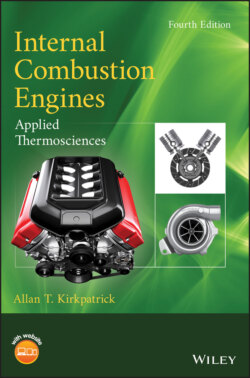Читать книгу Internal Combustion Engines - Allan T. Kirkpatrick - Страница 60
Solution
ОглавлениеThe program input portion of FourStrokeOtto.m is shown below.
four-stroke Otto cycle model Input parameters: Ti = 300; inlet temperature (K) Pi = 50; inlet pressure (kPa) Pe = 100; exhaust pressure (kPa r = 10; compression ratio qin = 2500; energy addition, kJ/kg (gas) R = 0.287; gas constant (kJ/kg K) f = 0.05; guess value of residual fraction f Tr = 1000; guess value of exhaust temp (K) tol = 0.001; convergence tolerance ....
For the above conditions, as shown in Tables 2.3 and 2.4, the computation indicates that the intake stroke temperature rise, , is about 45 K, and the exhaust blowdown temperature decrease, , is about 280 K. The volumetric efficiency, , the net thermal efficiency, , and the residual fraction, 0.053.
Table 2.3 State Variables for Four‐Stroke Example 2.3
| State | 1 | 2 | 3 | 4 |
| Pressure (kPa): | 50.0 | 997.6 | 4582.6 | 229.7 |
| Temperature (K): | 345.3 | 688.9 | 3164.3 | 1585.9 |
Table 2.4 Computed Performance Parameters for Four‐Stroke Example 2.3
| Residual Fraction | = | 0.053 |
| Net Imep (kPa) | 612.0 | |
| Ideal Thermal Efficiency | = | 0.499 |
| Net Thermal Efficiency | = | 0.461 |
| Exhaust Temperature (K) | 1309.0 | |
| Volumetric Efficiency | = | 0.91 |
Volumetric efficiency for Example 2.3. Residual fraction for Example 2.3.
The volumetric efficiency, Equation (2.63), the residual fraction, Equation (2.47), and the net thermal efficiency (Equation (2.67)) are plotted in Figures 2.13, and 2.14, respectively, as a function of the intake/exhaust pressure ratio.
Comment: As the pressure ratio increases, the volumetric efficiency and thermal efficiency increase, and the residual fraction decreases. The dependence of the volumetric efficiency on compression ratio is reversed for the throttled and supercharged conditions. In addition, the residual gas fraction increases. The increase in residual fraction is due to the decrease in the intake mass relative to the residual mass as the intake pressure is decreased.
Net thermal efficiency for Example 2.3.
